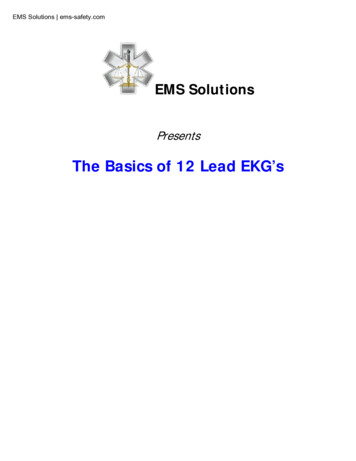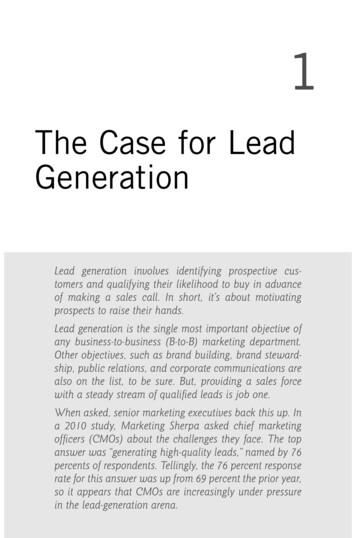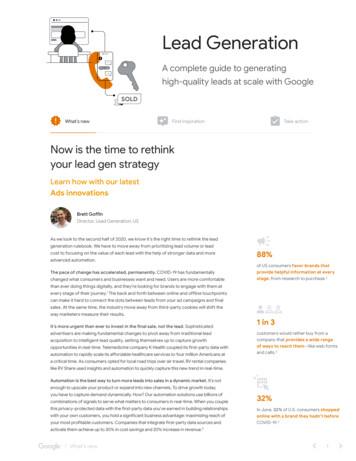
Transcription
EMS Solutions ems-safety.comEMS SolutionsPresentsThe Basics of 12 Lead EKG’s
EMS Solutions ems-safety.comNOTICE: You DO NOT Have the Right to Reprint or Resell this Publication.However, you MAY give this report away, provided you do not change or alterthe contents. Copyright EMS Solutions ALL RIGHTS RESERVED. No part of thispublication may be reproduced or transmitted in any form whatsoever,electronic, or mechanical, including photocopying, recording, or by anyinformational storage or retrieval system without the expressed written, datedand signed permission from the author.DISCLAIMER AND/OR LEGAL NOTICES:The information presented herein represents the views of the author as of thedate of publication. Because of the rate with which conditions change, the authorreserves the right to alter and update this information based on the newconditions. The publication is for informational purposes only. While everyattempt has been made to verify the information provided in this publication,neither the author nor its affiliates/partners assume any responsibility for errors,inaccuracies or omissions. Any slights of people or organizations areunintentional. If advice concerning medical, legal or related matters is needed,the services of a fully qualified professional should be sought. You should beaware of any laws/practices or local policies which govern emergency care orother pre hospital care practices in your country and state. Any reference to anyperson or business whether living or dead is purely coincidental.
EMS Solutions ems-safety.com12-LEAD ECG INTERPRETATIONINTRODUCTIONThe objective of this report is to provide Paramedics with basic knowledgeprior to the introduction of acquiring 12-lead ECGs as part of their scope of practice.Acquisition of 12-lead ECGs will become an additional tool, along with currentassessment skills, for identifying patients suffering from an acute myocardial infarction.The importance of obtaining a 12-lead ECG is for early identification of potentialmyocardial ischemia so that the cause can be appropriately treated and, hopefully,reversed.Don’t be alarmed if you have difficulty with rhythm interpretation or reading a Lead IIstrip. When reading a 12-lead ECG, you are looking for different information that is notseen in the basic Lead II strip. These differences will become obvious to you as youwork through this package.Why 12-Leads? I Have Enough Problems with Lead II!This question is constantly being asked by paramedics that see the tracings of a 12lead ECG as something too imposing for them to even consider being useful inprehospital care. This is primarily due to the fact that we normally look at a tracinggenerated by our monitors (Lead II) and we are expected to be able to quickly come upwith one of the fancy names for the bizarre, electrically generated line. Doctorsfrequently argue over what the Lead II tracing reveals and this is why it is referred to asrhythm interpretation. One individual or doctor’s interpretation can be different fromanother and that is frequently acceptable as long as the rules of rhythm interpretationwere used. A 12-lead ECG is much more specific as it is a diagnostic tool looking at theelectrical activity of various sections of the heart simultaneously. It can allow the personreading the 12-lead ECG to identify early signs of ischemia, injury and infarction of veryvaluable heart muscle.By obtaining a 12-lead ECG early in our prehospital assessment, we are also able toprovide a “premedicated” picture of the electrical activity of the heart. How important isthis? We have all heard the story of a patient that a crew picked up, assessed ashaving ischemic chest pain, treated with oxygen, nitroglycerin and ASA, and arrived atthe hospital with the patient being pain free. The patient was assessed, includinghaving a 12-lead ECG done, and was discharged prior to completion of the ACR. Theambulance crew working the next shift found the patient VSA. This is a scenario thatcan happen to any one of us. Will the 12-lead prevent this from ever happening again,if the ECG obtained in the emergency department did not show anything? No, it maynot prevent it from happening again but having a 12-lead ECG of the patient’s electricalconduction in the myocardium may provide enough information to encourage the doctorto order additional tests to rule out a myocardial infarction (MI) and, if necessary, takethe appropriate steps to prevent a reoccurrence.4
EMS Solutions ems-safety.comConsider this - approximately 50% of MIs result in prehospital death due to arrhythmias(VF). Paramedics, as well as the community at large, have been educated regardingthe reduction of deaths due to arrhythmias possible from the use of rapid defibrillation.The next logical step is the reduction of these fatal arrhythmias. Studies show that thefirst 60 minutes following the onset of ischemic chest pain is the time of highest risk forVF or VT; we need to try to affect care in this 60-minute window. When you alsoconsider that, due to denial or lack of identification, many patients wait greater than twohours before seeking assistance, we as paramedics or as one of the first links of thechain of life are already working on borrowed time. Early identification of the signs of amyocardial infarction by the patient, by EMS with appropriate prehospital care and bythe emergency department should reduce this 50% mortality rate in MIs1.GETTING STARTEDWe will be looking at only one main aspect of the 12-lead ECG and that is to be able torecognize and localize an Acute Myocardial Infarction (AMI). While many aspects of 12lead interpretation require much study and practice, we will be focusing on identifyingthe pattern of ST segment elevation produced by an AMI. To do this we must useconsistent terminology and reference points on the 12-lead printout.We will start at the very beginning with the paper the tracing is printed on. It is the samepaper the monitor normally prints on, so all of the same factors apply.o Small squares 1 mm in height and 1 mm in widtho Large squares 5 mm in height and 5 mm in widthYou require this knowledge because when assessing the 12-lead ECG you will belooking for ST segment elevation greater than 1 mm. Knowing that one small square is1 mm in height means you do not require a measuring tape.The paper runs at a constant speed of 25 mm/sec, so 1 small square (1 mm in width)equals 0.04 seconds. Each block of 5 small squares (5 mm or one large square) equals0.20 seconds. This information is needed to help calculate rate and other timedintervals of the ECG. A major difference between a tracing used for rhythminterpretation and the tracing of the 12-lead is in the time. Strips between 6 and 10seconds are required for rhythm interpretation to be able to review the pattern and,therefore, identify the rhythm. The 12-lead tracing prints approximately only 2.5seconds of the rhythm which is not enough to do accurate rhythm interpretation but isusually enough to give you one good complex in each lead. With the 12-lead youcompare the complexes generated simultaneously by the various “views” or leads.5
EMS Solutions ems-safety.comIdentifying Components of the ECG (A Review)P WaveThe P wave is the first positive (upward) deflection on the ECG. It represents atrialdepolarization (contraction). It is normally nicely rounded and precedes the QRScomplex. The QRS complex may not always be “related” or following a P wave ifconduction disturbances are present. Changes in the shape of the P wave or inversion,indicate a change in the originating site of the P wave in the atria. This is frequentlyreferred to as a wandering pacemaker.Q WaveThe Q wave is a negative wave preceding an R wave. Not allcomplexes have a visible Q wave, but if there is any negativedeflection in front of the R wave, it is labeled a Q wave.When a Q wave is noted in any lead, always measure its width andheight. The width is measured from the start of the downwarddeflection to its return to the isoelectric line. When present a QQ Wavewave that is less then 0.04 seconds ( 1 small square in width) induration is referred to as a physiological Q wave and is considered a normaloccurrence. A Q wave that is greater then 0.04 seconds ( 1 small square in width) andis at least 25% of the height of the R wave is considered a pathological Q Wave andindicates irreversible damage (necrosis). This may be part of the presenting complaintor indicative of a previous infarction.R WaveThe R wave is the first positive deflection of the QRS complex. Nomatter where it occurs in the complex, the R wave is the firstpositive deflection above the isoelectric (base) line.The R wave includes the upstroke and the down stroke returning tothe isoelectric line.R WaveS WaveThe S wave is a negative deflection following the R wave. Measuring the S wave is thesame as the Q and R waves; it starts at the base line and returns to the base line.6
EMS Solutions ems-safety.comThe R and S waves combined represent the sum of electricalforces resulting from simultaneous depolarization of the right andleft ventricles (systole, contraction). It is possible to have morethen one R wave and more then one S wave in a complex. Thiswill be discussed further at a later time but, for now and for yourreference, this is often what you will hear people refer to as “bunnyears” which is indicative of a bundle branch block.S WaveThe combination of the Q, R and S waves makes up the QRScomplex. The normal QRS complex is narrow and sharply pointed. Its width isconsidered normal if less than 0.12 seconds or 3 small boxes. If the QRS complex isequal to or greater than 0.12 seconds or 3 boxes, this is indicative of some sort ofconduction problem through the heart tissue.T WaveThe T wave follows the QRS complex and represents the repolarization of theventricular myocardial cells. It is identified as the first deviation from the ST segmentand ends where the wave returns to the baseline. The shape of the T wave canindicate different aspects of myocardial health. Healthy myocardial tissue will produce arounded, slightly asymmetrical positive deflection. Inverted or depressed T waves mayindicate previous or current cardiac ischemia but are usually an early sign of an ongoingor current ischemic event. Elevated T waves ( half the height of the QRS complex) arereferred to as peaked or tented T waves and are usually indicative of new ischemia orhyperkalemia.J-PointThe J-point is the junction between the end of theQRS complex and the beginning of the ST segment.T WaveIt is best located by looking for the point where theQRS stops and makes a sudden sharp change indirection. Any time that you have measured theJ-Pointwidth of a QRS complex you have measured fromthe start of the Q wave to the end of the S wave which means you have identified the Jpoint many times so this should not be new to you, it now just has a name. The J-pointis used to help determine the length of the ST segment.ST SegmentThe ST segment is the portion of the ECGlocated between the J-point and the start of theT wave. For our purposes in reading a 12-leadECG the ST segment is probably the singlemost important element when looking for7T WaveSTP WaveTP
EMS Solutions ems-safety.comevidence of an Acute Myocardial Infarction. To determine if the ST segment is elevatedor depressed, we need an isoelectric base line. The TP segment is used to determinethe isoelectric baseline.TP SegmentThe TP segment is the section of the ECG between the end of one complex’s T waveand the beginning of the next complex’s P wave. This is where the tracing returns asclose as possible to the baseline or isoelectric line. It is important to use the TPsegment as your reference point as there are times that if the PR segment was used itcould be depressed and give the illusion of ST segment elevation.WHAT’S IN A LEAD?An important point in 12-lead interpretation is knowing which part of the heart each lead“views”. This, combined with knowing what changes can take place in each of thoseleads, can result in the recognition of an acute myocardial infarction. Early identificationof an acute myocardial infarction and early treatment can lead to reperfusion of valuablemyocardium preventing both tissue death and the potential for a life threateningarrhythmia.Let’s review some basic terminology so that we are all talking the same language aboutthe same things:Electrode – the end of the wire that connects the patient to the monitorCables – the bundle of wires used to connect electrodes from the patientto the monitorLead – made up of a negative and positive electrode that looks at differentaspects of the heart depending on where the electrodes are locatedrelative to each other.This may seem basic but keeping these terms straight will help out as we move along.A 12-lead ECG is made up of a tracing of the electrical activity of the heart from 12different points of view. The point of view comes from the location of the positiveelectrode of each lead. The positioning of these electrodes is broken down into 3categories, the limb leads (lead I, II & III), the augmented leads (aVR, aVL & aVF) andthe precordial or chest leads (V1, V2, V3, V4, V5 & V6).8
EMS Solutions ems-safety.comThe 12-lead ECG, when printed, is laid out in a standard fashion as per the diagram.We will look at this again a little later on.IaVRV1IIaVLV2V5IIIaVFV3V6V4Limb LeadsIt is important to remember where the positive and negative electrode of each lead isplaced in relation to the heart, so that you can identify which part of the heart the lead islooking at. If you were to place a camera at the positive electrode, facing the negativeelectrode, you would be taking a picture of the area of the heart that particular lead islooking at. The lead we are most familiar with is Lead II, which is one of the limb leads.Lead I, Lead II and Lead III combine to form a triangle around the perimeter of the heart.This tr
rhythm interpretation. One individual or doctor’s interpretation can be different from another and that is frequently acceptable as long as the rules of rhythm interpretation were used. A 12-lead ECG is much more specific as it is a diagnostic tool looking at the electrical activity of various sections of the heart simultaneously. It can .











